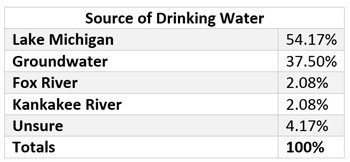
(Doug Kerr, Flickr Creative Commons) https://www.flickr.com/photos/dougtone/7130245837/in/photostream/
This shot of Aurora, Ill. illustrates how much a part of our lives water is. It's important not to take such a precious resource for granted.
It’s always exciting to start a new job, and I am thrilled to join the Metropolitan Planning Council (MPC) team in 2015. What makes the transition even more exciting is the ability to announce that MPC and Chicago Metropolitan Agency for Planning are reinvigorating regional water supply planning and implementation in 2015 as well.
Earlier this month, the two organizations began co-facilitating water supply planning meetings for Northeastern Illinois, titled: Water 2050 Regional Forum. This regional initiative is part of an envisioned long-term effort (as outlined in an Action Plan by the Ill. Dept. of Natural Resources) to ensure prudent research and collaborative planning occurs statewide. As the most recent drought in 2012 demonstrated, Northeastern Illinois is not immune to supply shortages. Being prepared with robust data and responsible policies when water scarcity hits not only makes logical sense, it ensures livability and economic viability for our state.
“Based on the data, it is clear that continued rapid population growth and economic activity will put a strain on the region’s current supply, and significant shortages could result without coordinated action...”—Bonnie Thomson Carter, Lake County Board member
MPC has been at the forefront of supporting regional planning efforts related to water supply for quite some time. Beginning with MPC and Openlands’ release of Changing Course in 2004, Troubled Waters in 2005 and Before the Wells Run Dry in 2009, MPC has been a partner in advocating and steering attention toward the need for increased regional and state-level water supply planning. This effort came to a head in 2006 when an Executive Order was issued, calling for a comprehensive program for state and regional water supply planning and management and development of two regional water supply plans in Illinois.
From this directive as well as three years of research, public engagement and monthly meetings, Northeastern Illinois’ regional water supply/demand plan was born: Water 2050 was approved in 2010. I would encourage everyone to review this valuable document, which among other things outlines what sources of water are employed in our region and how much is being used, and provides estimates for how much water we will need in the future. The plan also highlights a real need for continued data collection in order to make informed policy decisions regarding how we govern ourselves with the supply available to us.

At the event, participants were polled to find out their main source of drinking water.
The first quarterly Water 2050 Regional Forum on Thursday, Jan. 15 had about 60 participants from around Northeastern Illinois, and as you can see from the graph at right, they rely on a diverse set of water sources. The event featured presentations by Ill. Dept. of Natural Resources, Office of Water Resources and the Illinois State Water Survey.
The world’s weather patterns are changing, and water has no allegiance to our human-made systems—consistent, iterative planning is imperative to forging sustainable and resilient solutions. That is the intention of these forums; to bring stakeholders together for informed dialog on regional issues surrounding water supply that are timely, engaging and effective. We welcome your input and participation in this year’s remaining quarterly forums, which are scheduled for April 16, July 16 and Oct. 15.
Wishing you a happy New Year, and here’s to holistic, collaborative and effective water planning for Illinois in 2015!